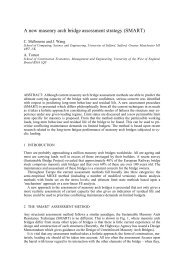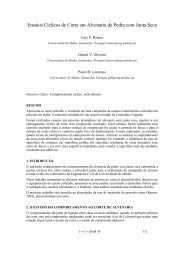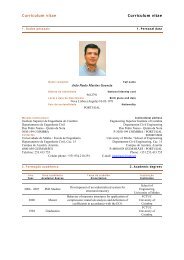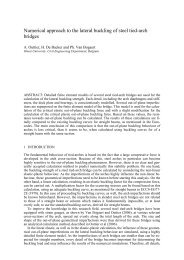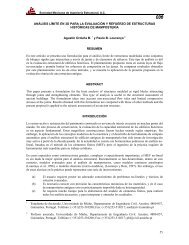an orthotropic continuum model for the analysis of masonry structures
an orthotropic continuum model for the analysis of masonry structures
an orthotropic continuum model for the analysis of masonry structures
Create successful ePaper yourself
Turn your PDF publications into a flip-book with our unique Google optimized e-Paper software.
TNO-95-NM-R0712 1995 9whereúκ t = úε p α = ⎛ 1 /2⎝ 1 / 2 (úεúε p ) T Q úεúε p ⎞+⎠1 / 2 π T úεúε p , (20)⎡ 1/⎢ 2⎢ − 1 / 2Q = ⎢⎢ 0⎢ 0⎣− 1 / 21/ 20000000⎤⎥⎥⎥⎥⎥⎦0. (21)012α g2.1 Return mapping algorithm - Tension regimeThe integration <strong>of</strong> <strong>the</strong> constitutive equations given above is a problem <strong>of</strong> evolution that c<strong>an</strong> beregarded as follows. At a stage n <strong>the</strong> total strain <strong>an</strong>d plastic strain Þelds as well as <strong>the</strong> hardeningparameter (or equivalent plastic strain) are known:{ε n , ε p n, κ t, n } given data . (22)Note that <strong>the</strong> elastic strain <strong>an</strong>d stress Þelds are regarded as dependent variables which c<strong>an</strong> bealways be obtained from <strong>the</strong> basic variables through <strong>the</strong> relationsε e n = ε n − ε p n <strong>an</strong>d σ n = D ε e n . (23)There<strong>for</strong>e, <strong>the</strong> stress Þeld at a stage n+1is computed once <strong>the</strong> strain Þeld is known. The problemis strain driven in <strong>the</strong> sense that <strong>the</strong> total strain ε n+1 is trivially updated according to <strong>the</strong> exact <strong>for</strong>mulaε n+1 = ε n +∆ε n+1 . (24)It remains to update <strong>the</strong> plastic strains <strong>an</strong>d <strong>the</strong> hardening parameter. These qu<strong>an</strong>tities are determinedby integration <strong>of</strong> <strong>the</strong> ßow rule <strong>an</strong>d hardening law over <strong>the</strong> step n → n+1. In <strong>the</strong> frame <strong>of</strong> afully implicit Euler backward integration algorithm this problem is tr<strong>an</strong>s<strong>for</strong>med into a constrainedoptimization problem governed by discrete Kuhn-Tucker conditions as shown by Simo et al.(1988). It has been shown in different studies, e.g. Ortiz <strong>an</strong>d Popov (1985) <strong>an</strong>d Simo <strong>an</strong>d Taylor(1986), that <strong>the</strong> implicit Euler backward algorithm is unconditionally stable <strong>an</strong>d accurate. Thisalgorithm results in <strong>the</strong> following discrete set <strong>of</strong> equations:ε n+1 = ε n +∆ε n+1σ n+1 = σ trial −∆λ t, n+1 D ∂g ⎪1⎪∂σ⎪ n+1, (25)ε p n+1 = ε n p ∂g 1⎪+∆λ t, n+1 ⎪∂σ⎪ n+1κ t, n+1 = κ t, n +∆κ t, n+1in which ∆κ t, n+1 results from <strong>the</strong> integration <strong>of</strong> <strong>the</strong> rate equation, eq. (19), <strong>an</strong>d <strong>the</strong> elastic predictorstep returns <strong>the</strong> value <strong>of</strong> <strong>the</strong> elastic trial stress σ trial asσ trial = σ n + D ∆ε n+1 . (26)The above equations must be satisÞed <strong>an</strong>d simult<strong>an</strong>eously <strong>the</strong> yield criterion must be fulÞlled


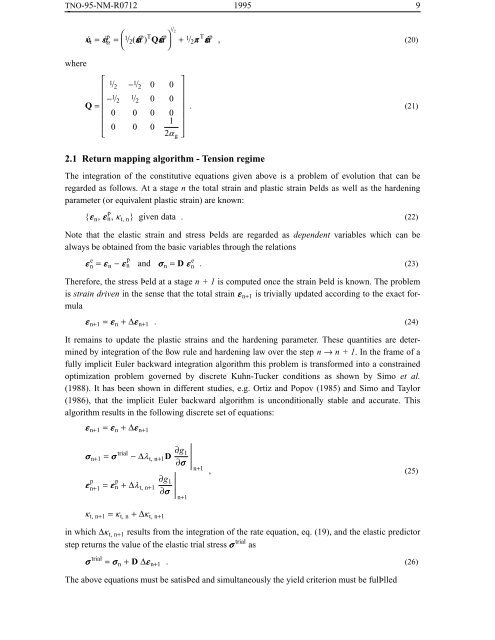
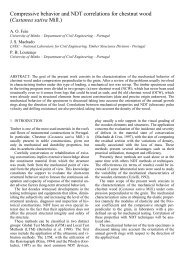
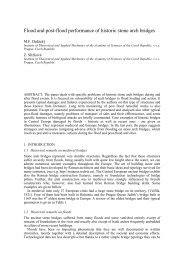
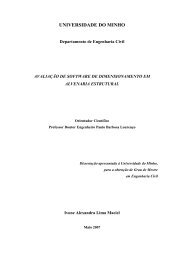

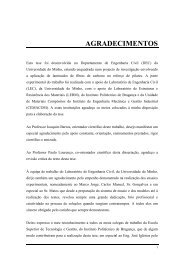

![Weibull [Compatibility Mode]](https://img.yumpu.com/48296360/1/190x134/weibull-compatibility-mode.jpg?quality=85)

